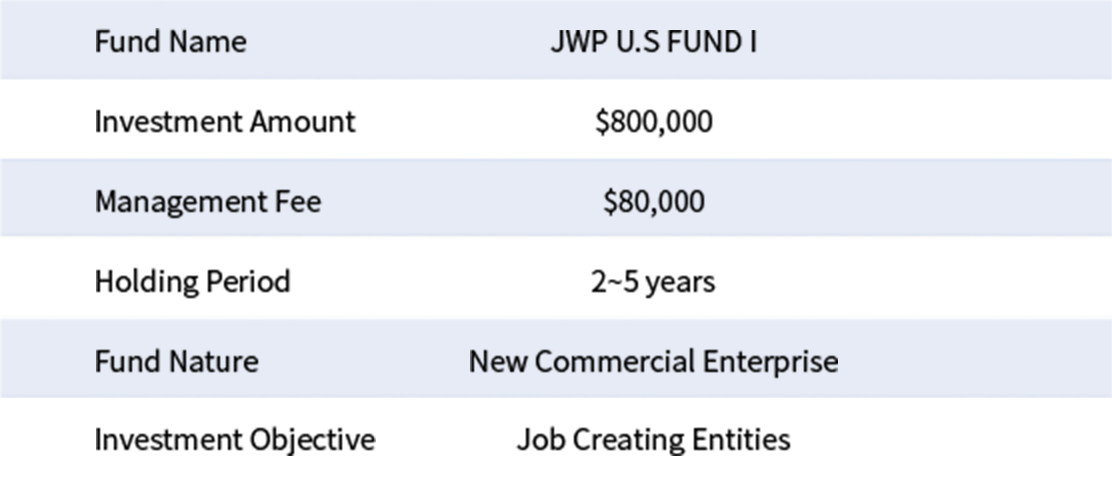JWP U.S. FUND I
JWP U.S. FUND I is an immigration fund established under the EB-5 Reform and Integrity Act of 2022. EB-5 is a U.S. immigration program, the fifth preference visa for immigrant investors, with a quota of 10,000 per year. As long as one meets the investment conditions set by the federal government and invests the funds in an approved investment fund or commercial project, one can obtain a U.S. green card and become a lawful permanent resident of the United States. Under the new policy, $800,000 will be invested in a designated TEA (Targeted Employment Area) to create 10 jobs and maintain for two years.

New policy of EB-5 from USCIS
FUND Elements

FUND Structure

Responsibilities from Each Parties under EB-5
It is the government agency that administers the EB-5 program. It is responsible for setting guidelines and overseeing compliance for the various entities participating in the program, including EB-5 Regional Centers, new commercial enterprises, job-creating entities, sponsors, and investors.
Invests $800,000 in the TEA region to obtain a U.S. green card. The investment period is 2-5 years, with an expected annual return of 1%
The GP is responsible for all record keeping required on behalf of the investor and the capital invested and the returns generated - annual accounting, annual tax returns, financial reporting and all the duties expected of the general partner to oversee the investment and keep the investor up to date.
An EB-5 Regional Center is a public or private entity in the United States involved in promoting economic growth. USCIS designates Regional Centers to participate in the Immigrant Investor Program.
The management of NCE is responsible for ensuring that the business operates in compliance with all relevant laws and regulations, manages the funds invested by EB-5 investors, and creates jobs in accordance with the requirements of the EB-5 program. Given the importance of job creation to the EB-5 program, NCE management plays a critical role in ensuring that the business is structured to maximize job creation and meets the job creation requirements set forth by USCIS. In addition, NCE management is responsible for providing USCIS with the necessary documentation and evidence that the job creation requirements have been met.
A JCE is a business entity responsible for creating and maintaining the required number of jobs (10) for EB-5 investors. A JCE can be any for-profit entity, such as a corporation, limited liability company, or partnership, that conducts lawful business activities that create jobs in the United States.
FUND Advantages

Diversified fund model, diversified investment, reduced investment risk, recognized and approved by the immigration authorities


Maintains control of the project, participates in major project decisions, and continuously monitors and participates in every step of the development and operational process


Alignment of interests - investors receive all capital and profits before the fund receives any.


Working with real estate developers with a proven track record of success, following rigorous due diligence, and providing audited quarterly and annual financial statements


Professional investment managers screen projects to ensure that the developer has locked in a bank loan before committing EB-5 capital.


Favorable capital structure for EB-5 investors, with a clear "exit mechanism" at the end of the investment period prior to the entry of funds.


EB-5 funds account for a low percentage of the investment in the project, to ensure that each investor can obtain the maximization of sufficient employment opportunities


Professional and well-known lawyers to escort the whole process

Reliable Track Record

JWP U.S. FUND I First JCE Details

United States Immigration History

The first climax of immigration, which American historians have called "the great human migration movement", occurred between 1820 and 1860, when the total number of immigrants amounted to 5 million. The immigrants came mainly from Western and Northern Europe, including about 2 million Irish, about 1.7 million Germans, and a large number of African slaves who had been trafficked to the United States. There were also a few immigrants from Asia, mainly Chinese who came to the United States to seek gold.
The second climax of immigration was from 1861 to 1880, when about 5 million immigrants came to the United States. After the end of the Civil War, the U.S. saw the peak of industrialization and a strong demand for labor. In order to attract European immigrants to the United States, in 1864, President Abraham Lincoln lobbied Congress to pass the Encouragement of Alien Immigration Act. Secretary of State Seward even issued a circular to U.S. diplomats in Europe, asking them to treat attracting European immigrants as a top diplomatic priority. In order to recruit skilled workers from Europe to work in the U.S., some companies also organized recruitment missions to Europe. They placed advertisements in many European newspapers and issued pamphlets depicting the attractive prospects of the United States for Europeans who wished to emigrate. Some companies also provided the necessary travel expenses for Europeans who wished to immigrate to the United States.
The third climax was from 1881 to 1920, when immigration jumped to 23.5 million. The peak of immigration was in 1907, when it reached 1.285 million. During this period, the U.S. government enacted several pieces of legislation to restrict European immigration and exclude Asian immigrants. While the growth of "old immigrants" from northwestern European countries such as Britain, Germany and Sweden was limited, the growth of "new immigrants" from southeastern European countries such as Italy and Russia was rapid.
As a result of these three waves of immigration, the total population of the United States exceeded 100 million for the first time in 1920. During the 100-year period from 1820 to 1920, the number of immigrants accounted for more than 20% of the annual growth of the U.S. population. These three waves of immigrants in the history of the United States not only had a profound impact on the formation of the national character of the United States of America, but also made the United States in just over a hundred years to rise rapidly, replacing the United Kingdom as the world's number one economic power, and for the future to become a world superpower to lay the foundation. It can be said that the wave of immigrants forged the strength of the United States.

